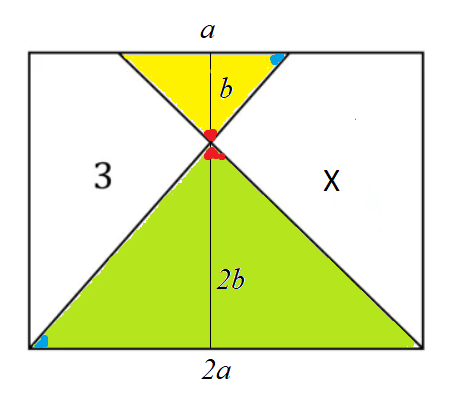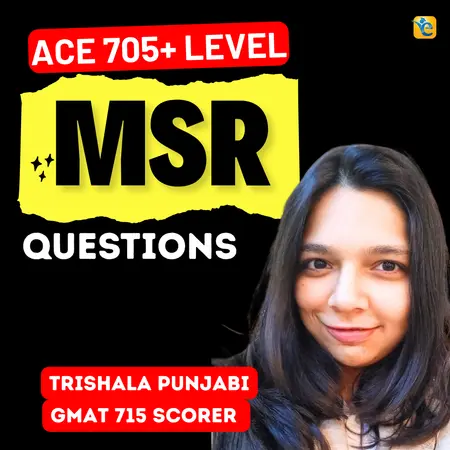Events & Promotions
|
|

GMAT Club Daily Prep
Thank you for using the timer - this advanced tool can estimate your performance and suggest more practice questions. We have subscribed you to Daily Prep Questions via email.
Customized
for You
Track
Your Progress
Practice
Pays
Not interested in getting valuable practice questions and articles delivered to your email? No problem, unsubscribe here.
- Nov 22
11:00 AM IST
-01:00 PM IST
Do RC/MSR passages scare you? e-GMAT is conducting a masterclass to help you learn – Learn effective reading strategies Tackle difficult RC & MSR with confidence Excel in timed test environment - Nov 23
11:00 AM IST
-01:00 PM IST
Attend this free GMAT Algebra Webinar and learn how to master the most challenging Inequalities and Absolute Value problems with ease. - Nov 25
10:00 AM EST
-11:00 AM EST
Prefer video-based learning? The Target Test Prep OnDemand course is a one-of-a-kind video masterclass featuring 400 hours of lecture-style teaching by Scott Woodbury-Stewart, founder of Target Test Prep and one of the most accomplished GMAT instructors.
Kudos
Bookmarks
D
Be sure to select an answer first to save it in the Error Log before revealing the correct answer (OA)!
Difficulty:
 95%
(hard)
95%
(hard)
Question Stats:
33% (01:57) correct 67%
(01:36)
wrong
67%
(01:36)
wrong  based on 294
sessions
based on 294
sessions
History
Date
Time
Result
Not Attempted Yet
A rectangle is divided into four regions with the areas of 1, 3, 4, and X, as shown above. What is the value of X?
A. 1
B. 2
C. 3
D. 4
E. Cannot be determined.
|
M37-103
Attachment:
2020-08-24_18-46-02.png
Experience GMAT Club Test Questions
Yes, you've landed on a GMAT Club Tests question
Craving more? Unlock our full suite of GMAT Club Tests here
Want to experience more? Get a taste of our tests with our free trial today
Rise to the challenge with GMAT Club Tests. Happy practicing!

Tanushka77

Current Student
Kudos
Bookmarks
Two triangles (with areas 1 and 4) are similar because of angles.
Ratio of their areas=4:1
Then Ratio of their sides=2:1
Then draw a height.
(x*h)/2=1
Xh=2
The area of the rectangle then would be 3h*2x=6xh=12
Subtracting other regions we get 12-(1+3+4)=4
The answer is D
Posted from my mobile device
Ratio of their areas=4:1
Then Ratio of their sides=2:1
Then draw a height.
(x*h)/2=1
Xh=2
The area of the rectangle then would be 3h*2x=6xh=12
Subtracting other regions we get 12-(1+3+4)=4
The answer is D
Posted from my mobile device
Attachments
IMG_20200902_064338.jpg [ 3.13 MiB | Viewed 7339 times ]
Kudos
Bookmarks
Let us take the triangles with area 1 and area 4. The two triangles will be similar since, one pair of angles are vertically opposite and the other angles are alternate interior angles, since the sides of rectangle are paralles.
Ratio of areas of the two triangles is 4:1.
Ratio of sides of the triangles is 2:1.
Let the side of the smaller triangle be y and height be h. so area =1/2 * y *h = 1
=> y*h=2
Now the side of the triangle with area 4 is 2y and height is 2h. So one side of the rectangle will be 2y and the other side will be h + 2h= 3h
Area of rectangle =3h * 2y =6hy = 6* (2) (since y*h =2)
= 12
Area of rectangle is 12.
so area of x = 12 - ( 1 + 3 + 4)
= 12 - 8
=4
So, D is the correct answer.
Ratio of areas of the two triangles is 4:1.
Ratio of sides of the triangles is 2:1.
Let the side of the smaller triangle be y and height be h. so area =1/2 * y *h = 1
=> y*h=2
Now the side of the triangle with area 4 is 2y and height is 2h. So one side of the rectangle will be 2y and the other side will be h + 2h= 3h
Area of rectangle =3h * 2y =6hy = 6* (2) (since y*h =2)
= 12
Area of rectangle is 12.
so area of x = 12 - ( 1 + 3 + 4)
= 12 - 8
=4
So, D is the correct answer.
















